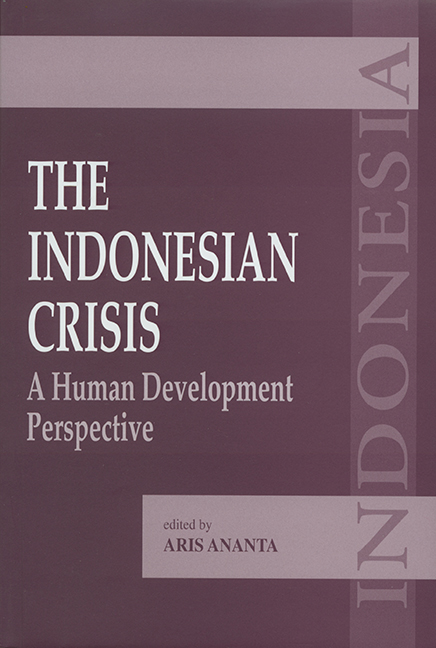Book contents
- Frontmatter
- Contents
- Acknowledgements
- List of Contributors
- Part I Introduction
- Part II Human Capital
- Part III Purchasing Power
- Part IV Emerging Issues
- 13 Political Economy of Business Relations between Indonesia and Singapore
- 14 Drug Abuse in Indonesia: An Increasing Problem During the Economic Crisis
- 15 Managing the Elderly in a Crisis Situation
- 16 The Indonesian Crisis in an Alternative Perspective: Views from Outer Indonesia
- Index
16 - The Indonesian Crisis in an Alternative Perspective: Views from Outer Indonesia
from Part IV - Emerging Issues
Published online by Cambridge University Press: 21 October 2015
- Frontmatter
- Contents
- Acknowledgements
- List of Contributors
- Part I Introduction
- Part II Human Capital
- Part III Purchasing Power
- Part IV Emerging Issues
- 13 Political Economy of Business Relations between Indonesia and Singapore
- 14 Drug Abuse in Indonesia: An Increasing Problem During the Economic Crisis
- 15 Managing the Elderly in a Crisis Situation
- 16 The Indonesian Crisis in an Alternative Perspective: Views from Outer Indonesia
- Index
Summary
Introduction
Were the achievements real? … Why have things gone wrong? Is it because Indonesia has been pursuing a wrong development strategy?
(Soesastro 1999, p. 1)What is referred to as “the Indonesian crisis” is commonly depicted as having started in July 1997, when the devaluation of the Thai bhat led other Asian currencies into a tailspin. The “monetary” crisis that ensued, the collapse of the financial sector, the loss of many industrial jobs, the austerity measures imposed by the International Monetary Fund (IMF), the difficult economic conditions for many, and intensifying protests, eventually led to the end of the 32-year presidency of, at that time, the longest reigning Asian leader. Just a year before, in 1996, despite escalating protests and unrest in Indonesia, articles in Asiaweek had pointed to the “economic fundamentals” as being still strong (Suh and Shameen 1996), and there was no “danger of collapse” (Berfield and Loveard 1996)2. Prominent economists also, even though they pointed out some of the misfits between macro-data and micro studies (Hill 1996, p. 195), as well as the difficulties in assessing the number of people living in “poverty” (Booth 1993), still had great praise for New Order Indonesia, which they had described as having gone, during Soeharto's reign, from a “basket case” to one of “Asia's success stories” (Hill 1996, pp. 1–3), or from a “drop-out” to a “miracle” (Booth 1999, p. 113).
Indeed, the conventional assessment still seems to be that even though Indonesia is now in economic ruins, the years of development were still beneficial to the population; one cannot undervalue what has been done, even though disaster has struck. For example, looking back over the New Order one analyst has painted the following picture:
Enormous progress was made in health, education, agriculture and poverty eradication, to mention a few of the most important fields. From 1969 to 1994 GDP (Gross Domestic Product) growth averaged 6.8 per cent and real GDP per capita increased more than threefold. From the early 1970's up to 1997 this economic development formed the basis for the regime's main claims to legitimacy.
- Type
- Chapter
- Information
- The Indonesian CrisisA Human Development Perspective, pp. 417 - 444Publisher: ISEAS–Yusof Ishak InstitutePrint publication year: 2002

